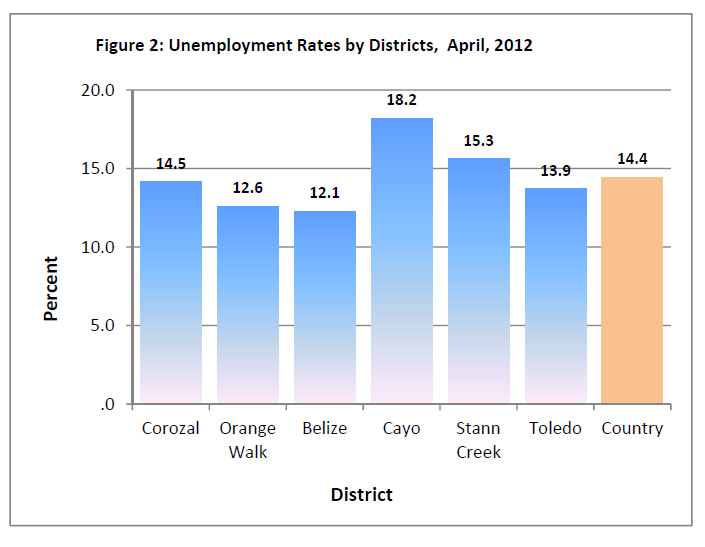Half the labor force not literate, survey says
BELIZE CITY, Mon. Aug. 20, 2012
The latest labor force survey indicates that unemployment rates have surpassed the record set in 1998, meaning that they are the highest on record for the past 14 years. Particularly high are the unemployment rates for youth and women. Of note, is that the district with the highest unemployment rate, Cayo, has seen its unemployment rate more than triple in the past five years.
The Statistical Institute of Belize (SIB) targeted 2,800 randomly selected households countrywide and got responses from about 85% of them. The survey is based on data from 9,980 respondents.
“Of the respondents who were of working age, 3,583 persons were classified as employed and 598 as unemployed, yielding a national unemployment rate of 14.4 percent,” said the SIB. “The female unemployment rate (22.3 percent) continued to be more than twice the male unemployment rate (9.1 percent).”
The unemployment rates are higher than any recorded over the past decade – 2002-2012, when the rate spanned 9 to 13%. In fact, according to the SIB, “these are the highest unemployment rates that Belize has experienced since April 1998 when the national rate was 14.3 percent, with similar percentages of males (10.6%) and females (21.3%) being out of work.”
Cayo’s unemployment rate was a mere 5.7% in April 2007, and now it leads at 18.2% – more than triple what it was in this latest survey. Corozal’s unemployment rate has likewise surged from 4.1% to the double-digit figure of 14.7%.
“Compared to April 2007, it is noteworthy that the unemployment rates in April 2012 were higher in all districts except Toledo,” said the survey report.
The Belize District recorded the lowest unemployment rate at 12.1%.
The employed population totaled 126,722 in April 2012; 57.2% were employed by private businesses and other non-government entities and 12.3 percent by the public sector, while 26.7 percent were self-employed and 3.6 percent were unpaid family workers. An estimated 78% were born in Belize, 10.3% in Guatemala and 1% in Mexico.
The median monthly income per worker was $886, 14% higher than five years ago, when it was $772. A total of 21,371 people in the labor force were unemployed and being supported either by a parent, spouse or child.
Almost a half (45.9 percent) of the unemployed labor force has been without work for more than twelve months. Of those who worked before, almost three-fourth (73.2%) previously worked in the services sector.
Rates more woeful among females and youth
The survey summary notes that females experience longer periods of unemployment than males. According to the data, “about a half of females (51.3 percent) have been unemployed for more than twelve months compared to about a third of males (36.7 percent).”
According to the SIB data, “about 79.4 percent of males 14 years or older are in the labor force while for females only 51.9 percent are in the labor force.”
Females ages 14-24 experience the most woeful unemployment rates and almost four out of every ten seeking jobs haven’t been able to get one. Whereas the general unemployment rate for females – those who want a job but can’t get one – is 22.3%, contrasting with only 9.1% for males, the rate for females ages 14-24 is a high 35.8%.
Unemployment is most prevalent among the youth 14 to 24 years (42.9 percent), and for those actually desiring work, 25.3% – one in four – can’t get a job.
“Since only about one fifth of the country’s total population are youth, it is clear that this age group is overrepresented among the unemployed,” said the survey summary.
Low literacy in labor force
The survey summary said, “…it is clear that at least 45.9 percent of the labor force is not literate.”
It noted that about half of Belize’s work force (more than 60,000 people) has no education and about 1 in 3 have completed only primary school. Meanwhile, 12% have completed up to high school and 6% tertiary education. Forty five percent of the 126,722 employed persons have no education, said the report. Additionally, within the employed labor force, almost three-quarters have at most a primary school education.
Ethnicity and unemployment
As of April 2012, the Maya have an unemployment rate of 18.6 percent, which is slightly higher than the rates of the Garinagu (17.4 percent) and the Creole (16.2 percent). In the Hispanic town of Orange Walk, Creoles experience their highest rate of unemployment – 29.6%. Meanwhile, Mestizos recorded the lowest unemployment rate (13.6 percent), according to the survey.
The Corozal District, dominated by a Mestizo population, has the highest proportion of working age persons in the labor force (71.0 percent) while the Toledo District—a mix of mostly Maya, Garinagu, East Indians and Creoles—has the lowest proportion of working age persons in the labor force, at 53.2 percent.

